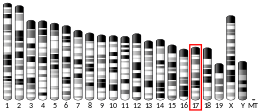DPP9
Dipeptidyl peptidase 9 is an enzyme that in humans is encoded by the DPP9 gene.[5]
| DPP9 | |||||||||||||||||||||||||
|---|---|---|---|---|---|---|---|---|---|---|---|---|---|---|---|---|---|---|---|---|---|---|---|---|---|
| Identifiers | |||||||||||||||||||||||||
| Aliases | DPP9, DP9, DPLP9, DPRP-2, DPRP2, dipeptidyl peptidase 9, DPP IX | ||||||||||||||||||||||||
| External IDs | OMIM: 608258 MGI: 2443967 HomoloGene: 16385 GeneCards: DPP9 | ||||||||||||||||||||||||
| |||||||||||||||||||||||||
| |||||||||||||||||||||||||
| |||||||||||||||||||||||||
| Orthologs | |||||||||||||||||||||||||
| Species | Human | Mouse | |||||||||||||||||||||||
| Entrez | |||||||||||||||||||||||||
| Ensembl | |||||||||||||||||||||||||
| UniProt | |||||||||||||||||||||||||
| RefSeq (mRNA) | |||||||||||||||||||||||||
| RefSeq (protein) | |||||||||||||||||||||||||
| Location (UCSC) | Chr 19: 4.68 – 4.72 Mb | Chr 17: 56.19 – 56.22 Mb | |||||||||||||||||||||||
| PubMed search | [3] | [4] | |||||||||||||||||||||||
| Wikidata | |||||||||||||||||||||||||
| |||||||||||||||||||||||||
This gene encodes a protein that is a member of the S9B family in clan SC of the serine proteases. The protein has been shown to have post-proline dipeptidyl aminopeptidase activity, cleaving Xaa-Pro dipeptides from the N-termini of proteins. Although the activity of this protein is similar to that of dipeptidyl peptidase 4 (DPP4), it does not appear to be membrane bound.
In general, dipeptidyl peptidases appear to be involved in the regulation of the activity of their substrates and have been linked to a variety of diseases including type 2 diabetes, obesity and cancer. Several transcript variants of this gene have been described but not fully characterized.[5]
References
- GRCh38: Ensembl release 89: ENSG00000142002 - Ensembl, May 2017
- GRCm38: Ensembl release 89: ENSMUSG00000001229 - Ensembl, May 2017
- "Human PubMed Reference:". National Center for Biotechnology Information, U.S. National Library of Medicine.
- "Mouse PubMed Reference:". National Center for Biotechnology Information, U.S. National Library of Medicine.
- "Entrez Gene: DPP9 dipeptidyl-peptidase 9".
Further reading
- Olsen C, Wagtmann N (2003). "Identification and characterization of human DPP9, a novel homologue of dipeptidyl peptidase IV". Gene. 299 (1–2): 185–93. doi:10.1016/S0378-1119(02)01059-4. PMID 12459266.
- Strausberg RL, Feingold EA, Grouse LH, et al. (2003). "Generation and initial analysis of more than 15,000 full-length human and mouse cDNA sequences". Proc. Natl. Acad. Sci. U.S.A. 99 (26): 16899–903. doi:10.1073/pnas.242603899. PMC 139241. PMID 12477932.
- Ajami K, Abbott CA, Obradovic M, et al. (2003). "Structural requirements for catalysis, expression, and dimerization in the CD26/DPIV gene family". Biochemistry. 42 (3): 694–701. doi:10.1021/bi026846s. PMID 12534281.
- Qi SY, Riviere PJ, Trojnar J, et al. (2003). "Cloning and characterization of dipeptidyl peptidase 10, a new member of an emerging subgroup of serine proteases". Biochem. J. 373 (Pt 1): 179–89. doi:10.1042/BJ20021914. PMC 1223468. PMID 12662155.
- Ota T, Suzuki Y, Nishikawa T, et al. (2004). "Complete sequencing and characterization of 21,243 full-length human cDNAs". Nat. Genet. 36 (1): 40–5. doi:10.1038/ng1285. PMID 14702039.
- Ajami K, Abbott CA, McCaughan GW, Gorrell MD (2004). "Dipeptidyl peptidase 9 has two forms, a broad tissue distribution, cytoplasmic localization and DPIV-like peptidase activity". Biochim. Biophys. Acta. 1679 (1): 18–28. doi:10.1016/j.bbaexp.2004.03.010. PMID 15245913.
- Gerhard DS, Wagner L, Feingold EA, et al. (2004). "The Status, Quality, and Expansion of the NIH Full-Length cDNA Project: The Mammalian Gene Collection (MGC)". Genome Res. 14 (10B): 2121–7. doi:10.1101/gr.2596504. PMC 528928. PMID 15489334.
- Ogasawara W, Tanaka C, Suzuki M, et al. (2005). "Isoforms of dipeptidyl aminopeptidase IV from Pseudomonas sp. WO24: role of the signal sequence and overexpression in Escherichia coli". Protein Expr. Purif. 41 (2): 241–51. doi:10.1016/j.pep.2004.10.027. PMID 15866709.
- Bjelke JR, Christensen J, Nielsen PF, et al. (2006). "Dipeptidyl peptidases 8 and 9: specificity and molecular characterization compared with dipeptidyl peptidase IV". Biochem. J. 396 (2): 391–9. doi:10.1042/BJ20060079. PMC 1462722. PMID 16475979.
- Yu DM, Wang XM, Ajami K, et al. (2006). "DP8 and DP9 have extra-enzymatic roles in cell adhesion, migration and apoptosis". Adv. Exp. Med. Biol. Advances in Experimental Medicine and Biology. 575: 63–72. doi:10.1007/0-387-32824-6_7. ISBN 978-0-387-29058-4. PMID 16700509.
- Yu DM, Wang XM, McCaughan GW, Gorrell MD (2006). "Extraenzymatic functions of the dipeptidyl peptidase IV-related proteins DP8 and DP9 in cell adhesion, migration and apoptosis". FEBS J. 273 (11): 2447–60. doi:10.1111/j.1742-4658.2006.05253.x. PMID 16704418.



